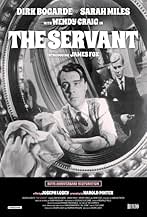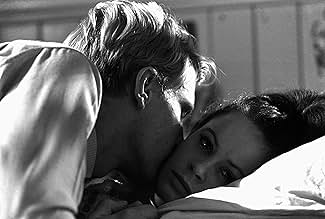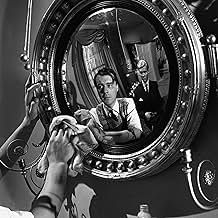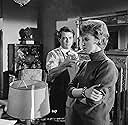IMDb रेटिंग
7.8/10
15 हज़ार
आपकी रेटिंग
अपनी भाषा में प्लॉट जोड़ेंUpper-class Tony hires servant Hugo Barrett, who turns out to have a hidden agenda.Upper-class Tony hires servant Hugo Barrett, who turns out to have a hidden agenda.Upper-class Tony hires servant Hugo Barrett, who turns out to have a hidden agenda.
- 3 BAFTA अवार्ड जीते गए
- 8 जीत और कुल 11 नामांकन
Doris Nolan
- People in restaurant: Older Woman
- (as Doris Knox)
फ़ीचर्ड समीक्षाएं
About midpoint Tony's girlfriend Susan asks servant Hugo, "What do you want from this house?" It's a direct and pointed question that's ambiguously answered ("I'm just the servant, mum.")
That ambiguity carries the dramatic tension along its murky but intriguing path, as a strange play of power and manipulation unfolds. Yet after a series of quirkly developments transpire and the tables of manservant and master are reversed, what's the real gain?
What was there in the house in the first place that was worth all the fuss and bother to acquire? Satisfaction of taking over the master role?
Whatever the goal, it all seems a tawdry victory. After the shoe's on the other foot and a few points are scored in this cheesy power game, where's the spoil?
What does drive this drama is Pinter's genius for inventing small talk that gives the illusion of grandeur Losey's direction is right on the mark, and the production design, score, photography--and the acting--are all top drawer.
As in his subversive play, "The Homecoming," Pinter manages to hold the attention with his unique pregnant pauses and hypnotic ambiance, which are actually illusionary. It could be a play about something very important or about nothing.
One thing is for certain: once "The Servant" is seen, one never quite forgets it.
This remains Dirk Bogarde's defining cinematic role.
That ambiguity carries the dramatic tension along its murky but intriguing path, as a strange play of power and manipulation unfolds. Yet after a series of quirkly developments transpire and the tables of manservant and master are reversed, what's the real gain?
What was there in the house in the first place that was worth all the fuss and bother to acquire? Satisfaction of taking over the master role?
Whatever the goal, it all seems a tawdry victory. After the shoe's on the other foot and a few points are scored in this cheesy power game, where's the spoil?
What does drive this drama is Pinter's genius for inventing small talk that gives the illusion of grandeur Losey's direction is right on the mark, and the production design, score, photography--and the acting--are all top drawer.
As in his subversive play, "The Homecoming," Pinter manages to hold the attention with his unique pregnant pauses and hypnotic ambiance, which are actually illusionary. It could be a play about something very important or about nothing.
One thing is for certain: once "The Servant" is seen, one never quite forgets it.
This remains Dirk Bogarde's defining cinematic role.
I first watched Losey's most famous work - but not quite his best, in my opinion - on the big-screen at London's National Film Theatre in 1999, just a few months after star Dirk Bogarde's death; it's certainly one of the latter's most significant roles (along with the homosexual composer of DEATH IN VENICE [1971], perhaps his most representative), though I still feel that VICTIM (1961) is the finest film he's ever been associated with!
Even so, Bogarde's performance (recipient of the BAFTA award) is understated most of the time - which rather suits his enigmatic title character, a self-described "gentleman's gentleman" but actually harboring sinister ambitions. Interestingly, when Joseph Losey fell ill in mid-production, the directorial chores were thrust into the hands of the leading man until his recovery - who, amusingly, initially turned Losey down by saying that he "couldn't direct a bus" if his life depended on it!
While he was still some years away from the deliberate formalism that virtually characterized all his later output, Losey's style is here more controlled - for lack of a better word - than in, say, THE CRIMINAL (1960) or EVA (1962); this may have been due to the 'failure' of the latter (see my review elsewhere), or perhaps his collaboration with screenwriter (and influential playwright) Harold Pinter may have had more to do with this than anything else. Still, Douglas Slocombe's sleek black-and-white cinematography (also a BAFTA award winner) of the gloomy London settings - abetted by Johnny Dankworth's wistful score - is certainly among the film's most notable assets.
James Fox's fine performance as the usurped master of the house led him to short-lived stardom (and even copped the young actor the "Most Promising Newcomer" award at the BAFTAs); his career went on an extended hiatus some years later (which ended in the mid-Eighties) following his traumatic experience on the set of PERFORMANCE (1970), curiously enough a film dealing with a similar role-reversal situation! Though the women are subservient to the central relationship between Bogarde and Fox, both Sarah Miles and Wendy Craig serve their characters well; especially interesting is the battle of wits between the latter (as Fox's upper-class girlfriend) and Bogarde, whom she mistrusts from the get-go and is obviously proved right beyond her wildest imagination!
For a two-hour dialogue-driven film, the plot is pretty sparse - typically of Pinter, dealing in symbolism rather than presenting a straightforward narrative (despite being based on a novel by Robin Maugham) - but the tension between the various characters holds the viewer's attention all the way...though the final descent into depravity and degradation comes off as rather too abrupt and now seems more farcical than shocking (as it must have seemed at the time)! The cast also includes bit parts by two alumni of Losey's THE CRIMINAL - co-star Patrick Magee and screenwriter Alun Owen, sparring amusingly as a couple of clergymen in a bar! - as well as Pinter himself (a former actor in his own right, appearing as a 'society man' in the same scene, actually one of the very few set outside Fox's mansion).
There's a hilarious scene in which James Fox goes with Wendy Craig to visit her "mummified" high society parents. This enables Bogarde and Miles to live it up at the house during their absence. However, they cut short their visit and catch them romping about in their master's bedroom, whereupon he sacks them on the spot. This leads to the film's best scene, in my opinion: the chance meeting in a bar between Bogarde and Fox (who has, in the interim, fallen on hard times) where the Mephistophelean Bogarde paints a pitiful picture of himself which, inevitably, leads the lonesome Fox to engage his services once more. The way Losey shoots this marvelous sequence is masterly - with a minimum of camera movement and the actors strategically placed within the frame.
Trivia note: I own a British periodical from the early 80s called "The Movie" - a collection of essays strung together more or less by theme and running for an impressive 158 volumes - in which THE SERVANT was among the films chosen for a two-page critical evaluation, accompanied by a detailed synopsis and illustrated by numerous stills; I've leafed through it and read the review (written by Derek Prouse) so many times that these images from the film have become fixed in my mind and, as I lay watching, I was actively looking out for each one of them!
Even so, Bogarde's performance (recipient of the BAFTA award) is understated most of the time - which rather suits his enigmatic title character, a self-described "gentleman's gentleman" but actually harboring sinister ambitions. Interestingly, when Joseph Losey fell ill in mid-production, the directorial chores were thrust into the hands of the leading man until his recovery - who, amusingly, initially turned Losey down by saying that he "couldn't direct a bus" if his life depended on it!
While he was still some years away from the deliberate formalism that virtually characterized all his later output, Losey's style is here more controlled - for lack of a better word - than in, say, THE CRIMINAL (1960) or EVA (1962); this may have been due to the 'failure' of the latter (see my review elsewhere), or perhaps his collaboration with screenwriter (and influential playwright) Harold Pinter may have had more to do with this than anything else. Still, Douglas Slocombe's sleek black-and-white cinematography (also a BAFTA award winner) of the gloomy London settings - abetted by Johnny Dankworth's wistful score - is certainly among the film's most notable assets.
James Fox's fine performance as the usurped master of the house led him to short-lived stardom (and even copped the young actor the "Most Promising Newcomer" award at the BAFTAs); his career went on an extended hiatus some years later (which ended in the mid-Eighties) following his traumatic experience on the set of PERFORMANCE (1970), curiously enough a film dealing with a similar role-reversal situation! Though the women are subservient to the central relationship between Bogarde and Fox, both Sarah Miles and Wendy Craig serve their characters well; especially interesting is the battle of wits between the latter (as Fox's upper-class girlfriend) and Bogarde, whom she mistrusts from the get-go and is obviously proved right beyond her wildest imagination!
For a two-hour dialogue-driven film, the plot is pretty sparse - typically of Pinter, dealing in symbolism rather than presenting a straightforward narrative (despite being based on a novel by Robin Maugham) - but the tension between the various characters holds the viewer's attention all the way...though the final descent into depravity and degradation comes off as rather too abrupt and now seems more farcical than shocking (as it must have seemed at the time)! The cast also includes bit parts by two alumni of Losey's THE CRIMINAL - co-star Patrick Magee and screenwriter Alun Owen, sparring amusingly as a couple of clergymen in a bar! - as well as Pinter himself (a former actor in his own right, appearing as a 'society man' in the same scene, actually one of the very few set outside Fox's mansion).
There's a hilarious scene in which James Fox goes with Wendy Craig to visit her "mummified" high society parents. This enables Bogarde and Miles to live it up at the house during their absence. However, they cut short their visit and catch them romping about in their master's bedroom, whereupon he sacks them on the spot. This leads to the film's best scene, in my opinion: the chance meeting in a bar between Bogarde and Fox (who has, in the interim, fallen on hard times) where the Mephistophelean Bogarde paints a pitiful picture of himself which, inevitably, leads the lonesome Fox to engage his services once more. The way Losey shoots this marvelous sequence is masterly - with a minimum of camera movement and the actors strategically placed within the frame.
Trivia note: I own a British periodical from the early 80s called "The Movie" - a collection of essays strung together more or less by theme and running for an impressive 158 volumes - in which THE SERVANT was among the films chosen for a two-page critical evaluation, accompanied by a detailed synopsis and illustrated by numerous stills; I've leafed through it and read the review (written by Derek Prouse) so many times that these images from the film have become fixed in my mind and, as I lay watching, I was actively looking out for each one of them!
If you watch closely you will find that not only does the internal decoration of the house change (in ways not included in the plot) to become gradually darker as Tony is gradually undermined and seduced by Barrett but also the excellent (but very much of its time) soundtrack by Johnny Dankworth & (surely - or is my recollection wrong?) Cleo Laine - though the same LP is put on the turntable many times, the arrangement of the same theme is different. (I did not notice this at first but found it pointed out in a special issue of the Oxford University magazine Isis at the time the film was released that was entirely devoted to it.) The film has recently reappeared in England as a stage work: Play without Words, seen at the National Theatre, is (was, I guess, is more accurate) a superb piece of dance theatre in which the ambiguities of the characters' motivations, or the discrepancies between their thoughts and actions, are portrayed by having more than one dancer per character. Sometimes only one is seen, sometimes they move in unison, sometimes in separate ways. It is extremely effective.
The song ' All Gone ' is played periodically through the duration of ' The Servant ' and it somehow sums the whole thing up. The period of the early sixties are long since gone, but the class divisions remain for better or worse ( mainly worse ) and in that sense the film is entirely relevant to today. I have seen this film only twice in my life, but giving myself a Joseph Losey ' season ' as they used to do, once upon the time, on the UK's BBC, but that too seems to be gone, reminds me of what we have lost in the cinema. Is it one of Losey's best films ? With certain reservations I think it is, and the merciless depiction of so-called ' order ' disintegrating into ' disorder ' sticks to the mind like glue. Except for a few exterior shots of Chelsea and a snow bound countryside the claustrophobia of the house in which the drama plays is palpable. You need air after watching this and to call it a drama is a bit of an overstatement. It is half way Harold Pinter and half way Samuel Beckett. Everything happens, and nothing happens, and the perennial Jean-Paul Sartre's ' Huis Clos ' and Harold Pinter's theatrical work in general, plus Samuel Beckett's ' Waiting for Godot ' come to mind. A closed universe without escape. Society's divisions of class and the trap of human life in itself are clearly visible. I am reluctant to give any spoilers except to say a manservant overwhelms the master of a house, and the temptations of losing control are too overwhelming for the master to resist. James Fox is excellent as the master, too passive to fight back and Dirk Bogarde gives arguably his best performance as a slightly camp manservant, and the obvious ( to me ) bisexuality between them also binds them together. Women are ' used ' in this scenario and to a certain extent Wendy Craig loses her righteous dignity and Sarah Miles as Bogarde's accomplice sinks further and further into self-degradation. It is perfect casting and Losey knew exactly what he was doing in choosing the actors. A party scene played as if it is in a mortuary appears dated, but looked at closely and listened to attentively it is entropy exemplified. A woman in black appears to hand out drugs to keep the master in a perpetual coma, and the other women in the room can barely move never mind indulge in any sexual acts. To sum up Losey sees a world collapsing into its inevitable oblivion. We the viewers watch, and despite having little background information about the characters we can draw own conclusions about what we are seeing, and like the people in the film gaze into mirrors as the only moorings to reflect our existence. A must see film but is its pessimism too hard to bear ?
This is a superb, sinister movie of the very highest class. Unlike the character Tony (James Fox) who is upper class without being high class, if you get my drift. You cannot really sympathise with Tony, who toys with some high falutin' development projects but basically is a wastrel just waiting to be ponced off. Tony is a later-day Bertie Wooster. The sinister element comes from the servant (Dirk Bogarde), who is no Jeeves. Barrett, like Jeeves , is a gentleman's gentleman or valet (not a butler as suggested in some other comments on this film). Tony needs a valet because he is incapable of doing anything much without help. Barrett and his accomplice Vera (Sarah Miles) take Tony to the cleaners, sweeping aside the fiancee Susan (Wendy Craig) in their wake.
Harold Pinter has written the screenplay in similar vein to the superb movie The Accident, also a Losey piece, which I also commend. The cinematography in both movies is simply excellent. The subject matter of The Servant suits Pinter, although much of the screenplay is not really in Pinter's voice. However, there is one scene, set in a restaurant, which includes a tiny cameo by Pinter himself and which contains a short Pinteresque exchange between two women. There is also one tense exchange between Susan and Barrett "do you wear deodorant" etc. which is very reminiscent of a scene in The Caretaker "you stink from arsehole to Thursday" etc. Indeed the story of The Servant resembles The Caretaker in many respects, except that in The Servant the interloper, Barrett, is on top and stays there, whereas in The Caretaker the interloper, Davies, lacks the skill and circumstances to dislodge the incumbent.
There is a homoerotic undercurrent to the film and this works so well because it is an undercurrent (in 1963 there could have been no more than an undercurrent even if they had wanted more). The overt debauchery with Vera and the orgy party towards the end of the film is the only bit of the film that has aged without grace. But I quibble.
This is a truly great film and it deserves to be more widely known.
Harold Pinter has written the screenplay in similar vein to the superb movie The Accident, also a Losey piece, which I also commend. The cinematography in both movies is simply excellent. The subject matter of The Servant suits Pinter, although much of the screenplay is not really in Pinter's voice. However, there is one scene, set in a restaurant, which includes a tiny cameo by Pinter himself and which contains a short Pinteresque exchange between two women. There is also one tense exchange between Susan and Barrett "do you wear deodorant" etc. which is very reminiscent of a scene in The Caretaker "you stink from arsehole to Thursday" etc. Indeed the story of The Servant resembles The Caretaker in many respects, except that in The Servant the interloper, Barrett, is on top and stays there, whereas in The Caretaker the interloper, Davies, lacks the skill and circumstances to dislodge the incumbent.
There is a homoerotic undercurrent to the film and this works so well because it is an undercurrent (in 1963 there could have been no more than an undercurrent even if they had wanted more). The overt debauchery with Vera and the orgy party towards the end of the film is the only bit of the film that has aged without grace. But I quibble.
This is a truly great film and it deserves to be more widely known.
क्या आपको पता है
- ट्रिवियाWhen producer and director Joseph Losey was hospitalized with a brutal case of pneumonia for two weeks during this shoot, Dirk Bogarde continued filming assisted by minute, daily instructions over the phone from Losey's hospital bed. When Losey returned to the set, he did not re-shoot any of the script, much to the relief of cast and crew. Bogarde managed to keep the film on schedule, though he later said the experience made him determined never to direct.
- गूफ़When Tony and Susan arrive at Tony's house in the Mercedes, with an extended visit in mind, they both go into the house and Tony leaves the car's lights on.
- भाव
Hugo Barrett: I'll tell you what I am. I'm a gentleman's gentleman, and you're no bloody GENTLEMAN!
टॉप पसंद
रेटिंग देने के लिए साइन-इन करें और वैयक्तिकृत सुझावों के लिए वॉचलिस्ट करें
- How long is The Servant?Alexa द्वारा संचालित
विवरण
बॉक्स ऑफ़िस
- US और कनाडा में सकल
- $45,522
- US और कनाडा में पहले सप्ताह में कुल कमाई
- $7,859
- 28 जुल॰ 2013
- दुनिया भर में सकल
- $76,278
- चलने की अवधि
- 1 घं 56 मि(116 min)
- रंग
- पक्ष अनुपात
- 1.66 : 1
इस पेज में योगदान दें
किसी बदलाव का सुझाव दें या अनुपलब्ध कॉन्टेंट जोड़ें






















